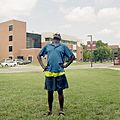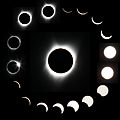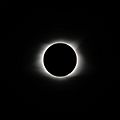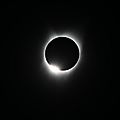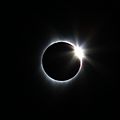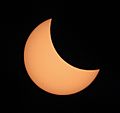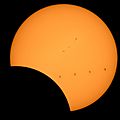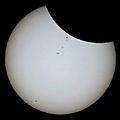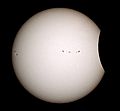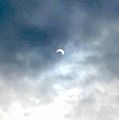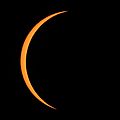Solar eclipse of August 21, 2017 facts for kids
On August 21, 2017, a special event called a total solar eclipse happened. This amazing sight could be seen across the United States. People in other parts of the world, like northern Canada, northern South America, northwestern Europe, northwestern Africa, and eastern Asia, were able to see a partial eclipse.
Contents
What is a Solar Eclipse?
A solar eclipse happens when the Moon passes directly between the Sun and Earth. When this happens, the Moon blocks the Sun's light. If the Moon completely blocks the Sun, it's called a total solar eclipse. If it only blocks part of the Sun, it's a partial solar eclipse.
The Path of Totality
During a total solar eclipse, there's a narrow path on Earth where the Sun is completely hidden. This is called the "path of totality." For the 2017 eclipse, this path went all the way across the United States, from Oregon on the west coast to South Carolina on the east coast. Millions of people traveled to be in this path to experience the full darkness of totality.
What People Saw
As the Moon slowly covered the Sun, the sky got darker, almost like twilight. Animals sometimes acted confused, and the air temperature could drop. During the few minutes of totality, the Sun's outer atmosphere, called the corona, became visible. It looked like a beautiful, glowing crown around the dark circle of the Moon. People also saw bright spots of light called Baily's beads and a "diamond ring" effect just before and after totality.
Watching the Eclipse
Many people gathered in parks, fields, and even college campuses to watch the eclipse. Special eclipse glasses or viewers were needed to look at the Sun safely before and after totality. Without them, looking directly at the Sun could hurt your eyes.
The Eclipse from Space
Even astronauts on the International Space Station (ISS) got a unique view! They could see the Moon's shadow, called the umbra, moving across the Earth's surface. This showed how big the shadow was and how fast it traveled.
Impact and Excitement
The 2017 solar eclipse was a huge event. Many people traveled to see it, which caused a lot of traffic in some areas. News channels like NASA TV had live coverage, and millions of people watched from home. It was a memorable day for science and for everyone who got to witness this amazing natural phenomenon.
Images for kids
-
The path of totality across the United States
-
Viewing the eclipse at Oregon State University
-
Totality over Timothy Lake, Oregon
-
People watching and photographing the eclipse in Yellowstone National Park
-
A crowd observes the eclipse in Ravenna, Nebraska
-
The Moon's umbra, as seen from the International Space Station
-
Traffic waiting to get on Interstate 25 at Glendo, Wyoming, after the eclipse
-
Traffic at a ramp to Interstate 75 near Sweetwater, Tennessee
-
Sequence starting at 9:06 am, totality at 10:19 am, and ending at 10:21 am PDT, as seen from Corvallis, Oregon
-
Totality and prominences as seen from Glenrock, Wyoming
-
Totality as seen from Columbia, Missouri
-
Totality as seen from Sweetwater, Tennessee
-
Totality as seen from Saint Paul, Clarendon County, South Carolina
-
Totality as seen from Newberry, South Carolina
-
Totality as seen from Grand Teton National Park, Wyoming
-
Beginning of Diamond ring as seen from Glenrock, Wyoming
-
Diamond ring as seen from Jay Em, Wyoming
-
Baily's beads before totality from far western Nebraska
-
Diamond ring as seen from Corvallis, Oregon
-
Diamond ring as seen from Saint Paul, South Carolina
-
Diamond ring as seen from Newberry, South Carolina
-
Diamond ring (with large flare) as seen from Cullowhee, NC
-
Diamond ring as seen from Grand Teton National Park, Wyoming
-
Seattle, Washington
-
North Cascades National Park, Washington. The ISS is visible as it transits the sun during the eclipse (4 frame composite image).
-
San Francisco, California
-
Far western Nebraska
-
Maine at 2:41 p.m. EDT before maximum 68% coverage at 2:45 p.m.
-
Ellicott City, Maryland shortly before maximum eclipse (~80%)
-
North Cascade mountains (British Columbia and Washington).
-
Tuxtla Gutiérrez (Chiapas), Mexico at 12:36 GMT-6.
-
Sunset from Zarautz, Basque Country, Spain
See also
 In Spanish: Eclipse solar del 21 de agosto de 2017 para niños
In Spanish: Eclipse solar del 21 de agosto de 2017 para niños











